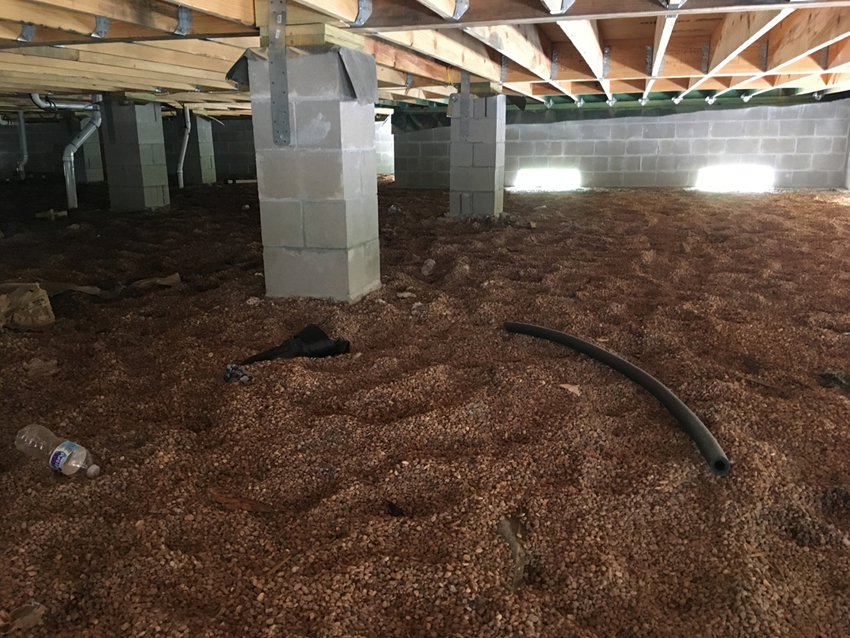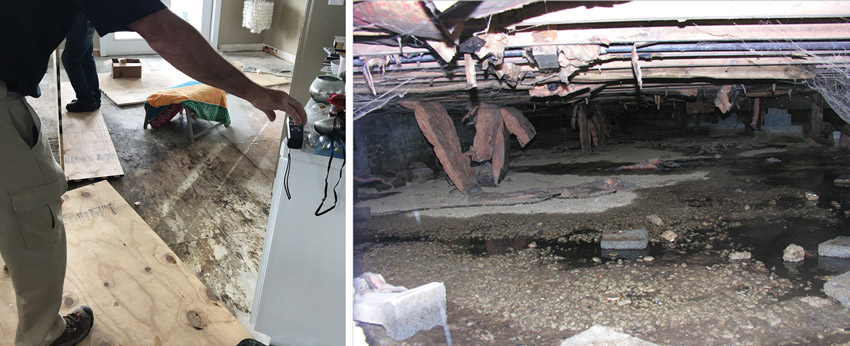The Building Science of Floor Systems
Sources of Vapor in Crawl Spaces
A well-designed crawl space that is based on the description above can certainly have bulk water, moisture, or water vapor present. There are five fundamental ways that can commonly happen as follow.
- Material porosity: Moisture can simply pass through any of the common materials that make up a crawl space. This is true for the walls, particularly if they are made of concrete masonry units but also for concrete. It is also true for the floor assembly in cases where a vapor drive condition moves between the conditioned space and the crawl space.
- Ground evaporation: The soil under and around buildings is organic and living primarily because soil is a great carrier and repository of water. That water can naturally make its way to the surface and evaporate up into the atmosphere. If that atmosphere is enclosed by a crawl space, then the moisture will build up there.
- Poor surface drainage: We all know water runs downhill, but to look at some finished grading around buildings, it would appear this design detail is sometimes forgotten. If water drains toward a crawl space, then it will likely enter and stay there, adding a new source of water, often with little if any means for draining it away.
- Humidity: Vent openings in walls are intended to allow for air to pass into and out of the crawl space. In southern climates in particular but common everywhere, this air can contain high amounts of moisture (i.e., humid air). That can combine with any other moisture already present and increase the moisture content in the crawl space even higher, rather than the intended condition of lowering it.
- HVAC: Crawl spaces are very common places to locate heating and cooling equipment, ducts, piping, etc. Sometimes, these systems contribute directly to the moisture or vapor in the crawl space through water that is drained or released. Other times, they can influence the conditions in the crawl space and create condensation on the ductwork or piping, especially if they are not insulated properly.
There can certainly be other causes as well, but these are the primary sources that we will concern ourselves with going forward.

Photo courtesy of Huber Engineered Woods, LLC
Moisture in a crawl space can come from multiple locations and sources.
The Role of Temperature
Water in general is affected a great deal by temperature, and this is true with water vapor and moisture too. At the most fundamental level, the temperature of the air will determine how much water vapor can be contained in that air until it reaches saturation. The warmer the air, the more water vapor, which explains why it often feels so much more humid in summer than in winter. Nonetheless, the relative humidity (RH) at any point in time is expressed as a percentage of water vapor in the air, so the same quantity of water vapor will produce a higher RH in cool air than it will in warm air. The fact that warm air can hold more moisture lowers the RH and means it has more capacity to hold even more vapor and feel more humid.
The other key aspect related to temperature is the dew point. This is the temperature where water vapor in the air begins to move out of a purely airborne state and turn into droplets of water. This can happen if humid air is suddenly cooled, thus losing capacity to hold vapor and becoming saturated. It can also happen if moisture-laden air comes into contact with a surface that is cool enough to be at or below the dew point. In this case, water droplets will condense on that surface, whether it is the outside of a cool drink container, a glass window cooled by air-conditioning, or a floor assembly cooled by the earth below it. Of course, in any of these cases, temperature, RH, and dew point are all interrelated and quite variable across a single day or season. They can also be influenced by other factors, such as heating and cooling degree days, barometric pressure, and local site conditions. Despite all of these moving targets, whenever the conditions are right, the laws of physics will kick in, and condensation will indeed occur.
The Problem with Moisture
Water and moisture are good and necessary for life and in fact help contribute to our human comfort and well-being. That is also true for trees that need water to grow and sustain life. Once those trees are cut down, dried of most of their moisture, and used for building materials, however, things change. Water is no longer desirable because the dried lumber and wood sheet products will now absorb water, which is something their cells have always done. In a living condition in the forest, this is all good, but in a static condition in a building, it is not since the absorption will change the shape of the wood (i.e., swelling, buckling, elongating, etc.).
Since the wood is no longer using the water to sustain its own life, any water that penetrates or saturates it will sit there and have other influences. If the wood does not properly dry out, then decay and rot can occur since the water now breaks down the wood instead of nurtures it. This is evident in all manner of wood-framed assemblies where water in any form has built up and not dried out. The organic nature of the dry wood and water simply does what it would on the forest floor, where a dead tree is being broken down by water and other factors and is reabsorbed into the earth. As the wood deteriorates, its structural capability goes with it, meaning structural failure could occur.
Other natural processes kick in if the temperature and moisture in the wood are in the range where mold and mildew can form. This not only can expedite the deterioration of the wood, but it can also contribute to indoor air quality (IAQ) issues, which can lead to health-related issues for people who are living inside. In the case of crawl spaces where HVAC systems are located, breaches of ductwork or openings around air filters, etc. can distribute some of these harmful conditions throughout the rest of the building.

Photos courtesy of Huber Engineered Woods, LLC
Moisture trapped in a floor assembly can deteriorate and damage wood and insulation to the point
of decreased performance or failure.
Other building products can become problematic too when moisture infiltrates them. Certain types of insulation are susceptible to the same types of deterioration in performance as wood. While some may not physically deteriorate, insulation manufacturers routinely point out that R-values will not be maintained if their product gets wet. Wet insulation can also provide fertile breeding areas for mold and mildew with the same negative impacts on the building and people as noted for wood.
The issue with moisture in crawl spaces then is that it can interact with building materials to create real problems. These include everything from minor nuisances to serious structural issues and human health problems. None of these should be taken lightly since they pose real threats to human safety and welfare, not to mention professional liability.
Code Considerations for Crawl Spaces
When it comes to the design of crawl spaces, most architects will defer to code requirements. However, there are actually a number of variations and exceptions, particularly in the International Residential Code (IRC), that are not always taken into account during design. We will be referencing the 2018 version of the IRC here, but many of the provisions are the same in earlier versions too.
First, it is important to be clear on how the code defines these spaces. The IRC addresses crawl space foundations in Section R408 as “under-floor space.” This generic term covers crawl spaces, flood-zone-created spaces, or spaces of any height that are “between the bottom of the floor joists and the earth under any building,” (R408.1). However, it specifically states, “except space occupied by a basement.” A basement is a term defined in Section 202 of the IRC as “a story that is not a story above grade plane.” There are further definitions of story and grade plane, but the point is that there are separate provisions for a basement than for a crawl space.
Some of the standard provisions applicable to crawl spaces are summarized as follows.









